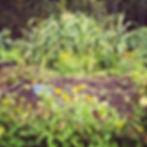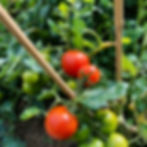Crop rotation
- Sofias Country Gardens
- Feb 14, 2020
- 5 min read

One of the key practices in organic gardening is the use of crop rotation, where no crops are grown in the same place in consecutive years. Crop rotation is often made out to be as difficult as rocket science, but this couldn't be further from the truth! Here I shall talk a little bit about how I do it and why I use my system of crop rotation.

Firstly I have divided my vegetable beds into four different raised beds. This is purely to keep it simple for myself, as I might as well have divided them into eight sections or any number that would work in my garden. For me, I like the visual purity of having four straight beds in the allotted spaces of a rectangle-shaped garden, and having raised beds in neat rows helps to keep order amongst the chaos as the edges and bark covered paths help to keep the weeds in check. As it is, I divide the four beds in halves, so that any crop takes eight seasons until it ends up in the first bed again.



My first bed is always the one with potatoes and sweetcorn. These are easy crops, not too greedy but they do like a good dolloping of manure to start with and then an even amount of water for the first six weeks of growth. Each year I say I'm too bloody fed up with the sweetcorn that doesn't mature in time for harvest, and each year I get a few really good ones that keep me suckered in to grow them next year too.... But if I didn't grow sweetcorn, I would surely pair the potatoes with squash, cucumber, peppers or tomatoes. (As it is, these crops go in the "miscancellous" department next to the kale plants...) Potatoes are a typical plant that needs to move places each year, as they are easily affected by potato scab. This unsightly disease is caused by a bacterium-like organism, Streptomyces scabies, that overwinters in soil and fallen leaves and stays in the ground for many seasons. By planting peas in this location next year, the cycle of the organism is disturbed while potatoes can be grown elsewhere in disease free environment. Eight years hence when the potatoes come back to this spot, chances are that it has a relatively healthy bed to grow in.


Bed number two has peas and beans. This is my favourite as there is nothing that quite compares growing legumes! As long as the soil is warm enough, these little darlings will pop up and grow like crazy until harvest. The only thing they hate is growing in the same spot year on year. Legumes fix nitrogen to the soil, and therefor I always grow them in the bed that hosted potatoes last year. That bed needs replenishing, and all peas and beans will do the trick. As they fix their own nitrogen to the soil, they are self-sufficient when it comes to fertilisers. What they do like, however, is a humus rich soil and they love a good mulch pf grass cuttings around their feet. In my garden I always grow at least three varieties of peas and beans, and if I could possibly squeeze in more I most definitely would!



Next up is the brassicas: kale, cauliflower, broccoli, brussel sprouts and kohlrabi. These are hungry monsters, and they always get to follow after the beans and peas that last year provided nutrients to the soil. They like to have a lot of nitrogen in the soil, and to produce the large leaves and vegetables they will hog a lot of it. As I don't use artificial chemicals, growing them in soil where peas and beans have grown helps the process. If needed, I will add some organic seaweed extract to give further a boost. I also stuff all the "miscancellous" in the far end of this bed as those are plants like celery, artichokes, squash, leeks and tomatoes that are as hungry feeders as the brassicas and appreciate the extra nitrogen that last years legumes have left in the soil. Next year though, I shall grow twice the amount of brassicas and move the miscancellous to the potato bed, but bearing in mind that potatoes aren't heavy feeders it is good to remember to feed these darlings a bit extra.



Root vegetables, on the other hand, don't like too much in the way of fertilisers. That is why these are perfect to grow in the bed where brassicas were last year. If root vegetables have too much fertiliser in the soil the leaves will grow like mad, leaving the root itself stumped and sometimes cracked. They prefer easy sandy soil to heavy clay, yet for years they managed while my clay became more loamy as I have added more compost year on year. Carrots and onions go together superbly, and apparently the onions keep the carrot flies at bay. I don't know if this is true, but it seems to work for me. I also like to plant Marigolds next to the carrots as companion plants for this reason. I do love my staples of carrots, onions and beetroot and I have had great success with this bed almost every year. (Once though, I planted the beetroots while it was still too cold and wet and they loathed it and hardly grew at all!) Other roots would be turnips, beets, radishes and parsnip. Parsnip, by the way, often gets attacked by cutworms and other critters (as can be seen in the picture below of the eaten leaves) and is therefore best moved to a new place each year as many of the buggs overwinter in the soil. Afterwards I grew some autumn beans in this place, and next year there will be potatoes or leafy greens, so the critter attack doesn't matter in the long run.



Although this is my rule of thumb, I will deviate from the plan as and when needed. This year I planted early spinach in between the sweetcorn plants, as I knew it would be ready long before the sweetcorn had even begun to grow. Spinach is actually a greedy leafy green that normally would be grown together with the brassicas, but as it is an early cropper I decided to grow it in-between-stuff instead. The week after midsummer my kind youngsters made a terrific job of harvesting all the spinach, and then the sweetcorn was mulched with grass cuttings and was none the worse off for having had a companion in bed for part of the season. Then there was a gap in the root vegetable bed after I had harvested my spring turnips around midsummer, which is why you might spot some later season Merveille de Piemonte beans growing next to Alma the scarecrow. I love beans, and I find that it is a great crop to fill in empty spots with! So in the end, as long as you have some kind of framework to organise your crops around so that they get the amount of nutrients they need and don't grow in the same spot many years in a row, I think you will be just fine. The main thing is to enjoy the adventure! Happy gardening to you!




